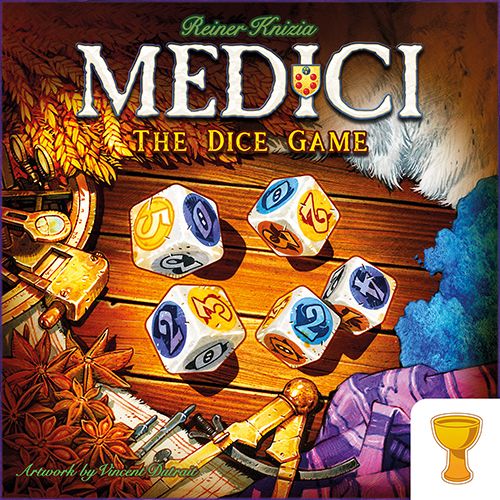Kickstart This! #147: Medici: The Dice Game

Designer: Reiner Knizia (Amun-Re, Battle Line, Blue Lagoon, Blue Moon City, Carcassonne: The Castle, Colossal Arena, Dream Factory, High Society, Ingenious, Lord of the Rings, Lord of the Rings: The Confrontation, Lost Cities, Medici, Modern Art, The Quest for El Dorado, Ra, Samurai, Scotten Totten, Taj Mahal, Through the Desert, Tigris & Euphrates, Winner’s Circle)
Artist: Vincent Dutrait (Broom Service, Dead Man’s Draw, Diplomacy, Discoveries: The Journals of Lewis and Clark, Elysium, Jaipur, Lewis & Clark, Lost Cities, Lovecraft Letter, Medici, Mythic Battles: Pantheon, New York 1901, Pathfinder Adventure Card Game: Rise of the Runelords – Base Set, The Quest for El Dorado, Raptor, Rise of Augustus, Robinson Crusoe: Adventures on the Cursed Island, Treasure Island, When I Dream, Wyatt Earp)
Publisher: Grail Games (Kashgar: Merchants of the Silk Road, Medici, Stephenson’s Rocket)
Genre/Mechanisms: card drafting, paper-and-pencil, roll-and-write, set collection
Funding Status: At the time of this posting, Medici: The Dice Game is already fully-funded. In fact, pledges currently total almost 3.5x the initial funding goal with less than 1 day left to go on the campaign!
Player Count: 2-4
Solo Mode: no
Complexity: medium-light
Risk: medium-low
What It’s About: A roll-and-write game played over 3 rounds that shares the setting and feel of previous Knizia Medici games.
How It Works: “In Medici: The Dice Game, players are buyers of fine goods that arrive at the docks from overseas lands. What goods arrive, and what their values are, are determined by the rolling of dice. In the course of the game, players will tally their three loads of ships and mark their monopolies on their score sheets. The game is played over 3 rounds. In the first round, players may only load goods onto their first ship, and in the second round, their second ship. Finally, when all the players have loaded their third ship, the game concludes with the scoring of the third round.”
At the start of a round, the active player rolls 5 dice, and selects 1-3 dice to keep. From the remaining dice, the other players each select 1; players are allowed to select the same die. The dice are then rolled by the next player, and the process is repeated. Each die value is first allocated to Ships, with players filling the left-most empty space of their current ship row. The space in the row below that space is also updated with the running total of the ship row. So when a player enters a 5 as their first number in a new ship row, they’ll also write 5 below it. If next they enter a 4, they’ll write 9 below it, so they always have a clear total of the ship row’s growing sum. Then the player will also mark off a space in one of the Monopoly columns that corresponds to the matching image on the die. When a player completes a ship row, they stop competing in that portion of the round (so only 3 ship rows are ever needed, 1 for each round, along with the 3 “running total” rows below each ship row).
At the end of each round, the player(s) with the highest ship row total scores a bonus. In a 2 player game, the bonus is 20 points for first and 0 for second; in a 3 player game, the bonus is 30 points for first, 15 points for second, and 0 for third; and in a 4 player game, the bonus is 30 points for first, 20 for second, 10 for third, and 0 for fourth. Players also score the number of points for the total of their ship row.
Next the players compare Monopolies, scoring bonus points for each row with the most check marks (there are 5 Monopoly rows). In a 2 player game, the bonus is 10 points for the player with the most check marks in each column and 0 for second; in a 3 or 4 player game, the bonus is 10 points for the player with the most check marks and 5 for second. Next, any player with 9 or more check marks in the same column scores an additional 10 bonus points; or 20 points for each column with 12 or more check marks.
Scoring is similar for the second and third rounds, with one caveat. Each round’s ship row is scored separately for that round. But the Monopoly columns are cumulative from round to round, so players do count the check marks from previous rounds when adding their Monopoly totals for the current round.
After the third round’s scoring, the player with the most points wins. Ties are broken by the player with the most check marks in any single column, and then by the player with the most check marks in their second-longest column, and so on.
Comparisons: Medici: The Card Game and the original Medici, an auction/bidding and set collection game with push your luck elements, are similar in theme and share ideas. A few other popular roll & write games include Railroad Ink, Roll Through the Ages: The Bronze Age, That’s Pretty Clever, Twice as Clever, and Welcome To…. Some recent promising roll & write Kickstarters have included Rome & Roll and Seven Bridges.
What Should I Pledge?:
$20 Medici Dice: a copy of the new Medici: The Dice Game.
$63 The Medici Family: a copy of Medici, Medici: The Card Game, and Medici: The Dice Game.
Add-Ons:
None.
KS Exclusives:
None.
All-In Total: In the continental U.S., you’re looking at $63 for The Medici Family and $10 in shipping for a total of $73.
Medici: The Dice Game completes its Kickstarter on Thursday, December 5th and tentatively ships in August 2020.